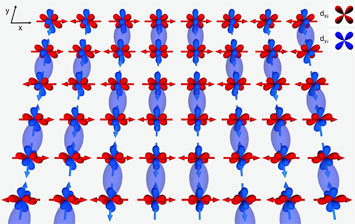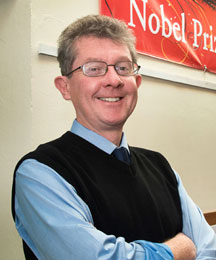Electron Orbitals May Hold Key to Unifying Concept of High-Temperature Superconductivity
Originally published by Brookhaven National Laboratory)
July 6, 2017

A team of scientists has found evidence for a new type of electron pairing that may broaden the search for new high-temperature superconductors. The findings, described in the journal Science, provide the basis for a unifying description of how radically different “parent” materials—insulating copper-based compounds and metallic iron-based compounds—can develop the ability to carry electrical current with no resistance at strikingly high temperatures.
According to the scientists, the materials’ dissimilar electronic characteristics actually hold the key to commonality.
“Scientists have thought that because the starting point for superconductivity in these two classes of materials is so different, you need different theoretical approaches to describe them,” said J.C. Séamus Davis, a physicist at the U.S. Department of Energy’s (DOE) Brookhaven National Laboratory and Cornell University, who led the team of experimental scientists. “Instead, we’ve been motivated to explore what is universal about these two systems. Ideally, there should be just one explanation.”
Davis is a member of the Kavli Institute at Cornell for Nanoscale Science.
Scientists have generally understood that the mechanism of superconductivity in copper oxide compounds depends on the ability of electrons on adjacent copper atoms to pair up. Each copper atom has a single, unpaired electron in its outermost energy shell, or orbital. While the outermost electrons on adjacent copper atoms interact with one another strongly, they ordinarily stay locked in place, stuck in a “quantum mechanical traffic jam” with nowhere to go, Davis said. With no electrons moving, the material acts as a “strongly correlated” electrical insulator.

Removing some of the electrons that reside on copper atoms results in electron vacancies known as holes. This alleviates the quantum traffic jam so that, when the material is cooled to a certain temperature, oppositely aligned electrons (magnetic partners where the “spin” of one electron points up and the adjacent one points down) form pairs and then become free to zip through the material unimpeded—a superconductor.
Iron atoms, which have a nucleus with smaller positive charge than copper, exert less pull on the circulating electrons. So instead of filling up electron orbitals, electrons in several outer energy orbitals remain unpaired, yet aligned with one another and electronically active. The alignment of unpaired electrons in multiple orbitals gives simple iron its strong magnetic and metal properties, so it’s easy to see why iron compounds would be good conductors. But it’s not really clear how they could become zero-resistance superconductors at high temperatures without the strong interactions that create a correlated insulating state in the copper based materials.
To address this conundrum, theoretical physicists began to consider the possibility that the unpaired electrons in iron’s different orbitals could take on very different roles. Perhaps unpaired electrons in one particular orbital could pair up with electrons in the same orbital on an adjacent atom to carry the supercurrent, while electrons in the other orbitals provide the insulating, magnetic, and metallic properties.

“The challenge is to find a way to see that some of the electrons are superconducting and some are insulating in the same crystal,” Davis said.
The research published in Science provides the first direct proof that such “orbital-selective” electron pairing takes place.
The theory team for this project—Andreas Kreisel (University of Leipzig), Peter Hirschfeld (University of Florida), and Brian Anderson (University of Copenhagen)—defined the electronic signatures that should be associated with each orbital on the iron atoms. Then, experimentalists Peter Sprau and Andrey Kostin (both of Brookhaven Lab and Cornell) used a scanning tunneling microscope at the Center for Emergent Superconductivity—a DOE Energy Frontier Research Center at Brookhaven Lab—to measure the energy and momentum of electrons in iron-selenide samples that were synthesized by Anna Bohmer and Paul Canfield at DOE’s Ames Laboratory. Comparing the measurements with the predicted electronic signatures allowed the scientists to identify which electrons were associated with each orbital.
With this information, “We can measure the binding energy and momentum of electrons in the ‘Cooper pairs’ responsible for superconductivity and identify which energy momentum characteristics they have—which orbital they’re from,” Davis said.
“We were able to show that almost all of the electrons in Cooper pairs in iron selenide were from a particular lower energy orbital (the dyz orbital),” Davis said. The findings also imply that the electron in iron’s outermost orbital in iron selenide exhibits virtually insulating properties, just as it does in the copper oxide compounds.
“Because iron selenide normally exhibits good metallic conductivity, how would one ever know that the electrons in this orbital are acting as they are in correlated insulators? This strongly interacting and virtually insulating state was hiding in plain sight!” he said.
With this outer-orbital insulating state, the iron compound has all the same requirements for superconductivity that the copper oxides do—a strong magnetic interaction (up/down pairing) of the almost localized electrons, and a metallic state that allows those pairs to move. The big difference is that in iron selenide, these contributions come from different electrons in three separate active orbitals, instead of the single electron in one active orbital in copper.
“In iron you have the conductivity for free. And you have the magnetism for free, but it’s based on a different electron. Both coexist in the same atom,” Davis said. So once you have Cooper pairs, it seems there’s no need to add holes to get the current flowing.
This realization may broaden the search for new superconductors that can potentially operate under warmer conditions. Such higher high-temperature superconductors would be more practical for real world, energy-saving applications such as power lines or energy storage devices.
“Instead of searching for new single-electron antiferromagnetic insulators like copper oxide to make high-temperature superconductors, maybe we should be searching for new highly magnetic, metallic materials that have properties like iron but in an orbitally selective arrangement,” Davis said. “This opens the world of materials science to many new types of materials that could be high-temperature superconductors.”
This research was funded by the DOE Office of Science, the Moore Foundation’s EPiQS Initiative, and a Lundbeckfond Fellowship.